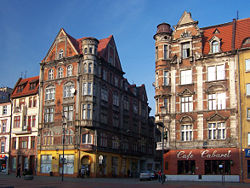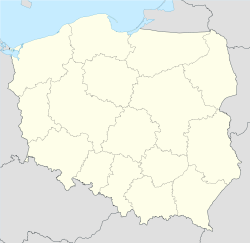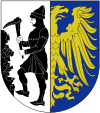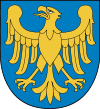Bytom
| Bytom | |||
 |
|||
|
|||
 Bytom
|
|||
| Coordinates: | |||
| Country | |||
|---|---|---|---|
| Voivodeship | Silesian | ||
| County | city county | ||
| Established | 12th century | ||
| Town rights | 1254 | ||
| Government | |||
| - Mayor | Piotr Koj (Platforma Obywatelska) | ||
| Area | |||
| - City | 69.43 km² (26.8 sq mi) | ||
| Highest elevation | 330 m (1,083 ft) | ||
| Lowest elevation | 249 m (817 ft) | ||
| Population (2007) | |||
| - City | 188,234 | ||
| - Density | 2,711.1/km² (7,021.8/sq mi) | ||
| - Metro | 3,487,000 | ||
| Time zone | CET (UTC+1) | ||
| - Summer (DST) | CEST (UTC+2) | ||
| Postal code | 41-900 to 41-936 | ||
| Area code(s) | +48 32 | ||
| Car plates | SY | ||
| Website: http://www.um.bytom.pl | |||
Bytom [ˈbɨtɔm] (![]() listen) (German: Beuthen) is a city in southern Poland with 188,234 inhabitants (2007). Since 1999 it has been situated in the Silesian Voivodeship, having previously been in the Katowice Voivodeship (1975-1998). Bytom is one of the main cities of the Upper Silesian Metropolitan Union with greater metropolitan area populated by 3,487,000 people.
listen) (German: Beuthen) is a city in southern Poland with 188,234 inhabitants (2007). Since 1999 it has been situated in the Silesian Voivodeship, having previously been in the Katowice Voivodeship (1975-1998). Bytom is one of the main cities of the Upper Silesian Metropolitan Union with greater metropolitan area populated by 3,487,000 people.
Contents |
History
Bytom is one of the oldest cities of Upper Silesia, having been known as Bitom in 1136 and Beuthen since 1440. It received German city rights in 1254 and grew owing to its location on a strategic crossroads. In 1259 it was raided by the Mongols. The Duchy of Opole was split and in 1281 Bitom became a separate duchy, since 1289 under overlordship and administration by the Kingdom of Bohemia. Due to German settlers coming to the area, the city was Germanized. It came under control of the Habsburg Monarchy of Austria in 1526, which increased the influence of the German language. The city became part of the Kingdom of Prussia in 1742 during the Silesian Wars and part of the German Empire in 1871. In the 19th and the first part of the 20th centuries, the city rapidly grew and industrialized.
In 1945 it was transferred to Poland as a result of the Potsdam Conference. Its German population was largely expelled by the Polish and Soviet armies and replaced with Poles, however some Silesian population did remain. In the post-war period the city did not experience significant investments.
Bytom is now a typical Polish post-industrial city. The majority of its coal mines are now closed, while its steel mills are slowly fading. The city is struggling to transform its economic profile from industry to services. Bytom cooperates with two cities with more or less the same problems: Recklinghausen in Germany, and Butte-Silver Bow, United States. The city has a considerable unemployment rate which is centered in the poorest part of the city, the Bobrek subdivision.
In 2007, Bytom and its neighbours created the Upper Silesian Metropolitan Union, the largest urban center in Poland.
Coat of arms
One half of the coat of arms of Bytom depicts a miner mining coal, while the other half presents a yellow eagle on the blue field - the symbol of Upper Silesia.
Education
- Universities:
- Silesian University of Technology - Faculty of Transport
- Medical University of Silesia
- Polish Japanese Institute of Information Technology
- Wyższa Szkoła Ekonomii i Administracji
- Secondary schools:
- I Liceum Ogólnokształcące im. Jana Smolenia
- IV Liceum Ogólnokształcące im. Bolesława Chrobrego
- 21 other secondary schools
Culture

- Opera Śląska (Silesian Opera) - ul. Moniuszki 21/23
- Miejska Biblioteka Publiczna (Town's Public Library)
- Śląski Teatr Tańca
- Bytomskie Centrum Kultury
The Confederation of Silesia
Bytom is a place where The Confederation of Silesia - Polish Bonapartists origins.
Politics
Bytom/Gliwice/Zabrze constituency
Members of 2001-2005 Parliament (Sejm) elected from Bytom/Gliwice/Zabrze constituency
- Jan Chojnacki, SLD-UP
- Stanisław Dulias, Samoobrona
- Andrzej Gałażewski, PO
- Ewa Janik, SLD-UP
- Józef Kubica, SLD-UP
- Wacław Martyniuk, SLD-UP
- Wiesław Okoński, SLD-UP
- Wojciech Szarama, PiS
- Krystyna Szumilas, PO
- Marek Widuch, SLD-UP
External links
- Municipality of Bytom
- Old postcards from Bytom
- Customs House of Bytom
- Pictures and history of Bytom
- Kino Gloria Fundation
|
||||||||||



